The cell therapy bioprocessing is expected to reach US$ 30,052.61 million in 2028 from US$ 11,192.50 million in 2020. The market is estimated to grow with a CAGR of 13.5% from 2021-2028.
The cell therapy bioprocessing market has been analyzed on the basis of technology, cell type, end user, and region. The market based on region is segmented into North America, Europe, Asia Pacific, the Middle East and Africa, and South and Central America. The report emphasizes on parameters such as market trends, technological advancements, market dynamics, and leading company’s competitive landscape analysis to offers insights and in-depth analysis of the cell therapy bioprocessing market. It also includes the analysis of COVID-19 pandemic across the market in all the key regions.
Customize This Report To Suit Your Requirement
You will get customization on any report - free of charge - including parts of this report, or country-level analysis, Excel Data pack, as well as avail great offers and discounts for start-ups & universities
Cell Therapy Bioprocessing Market: Strategic Insights
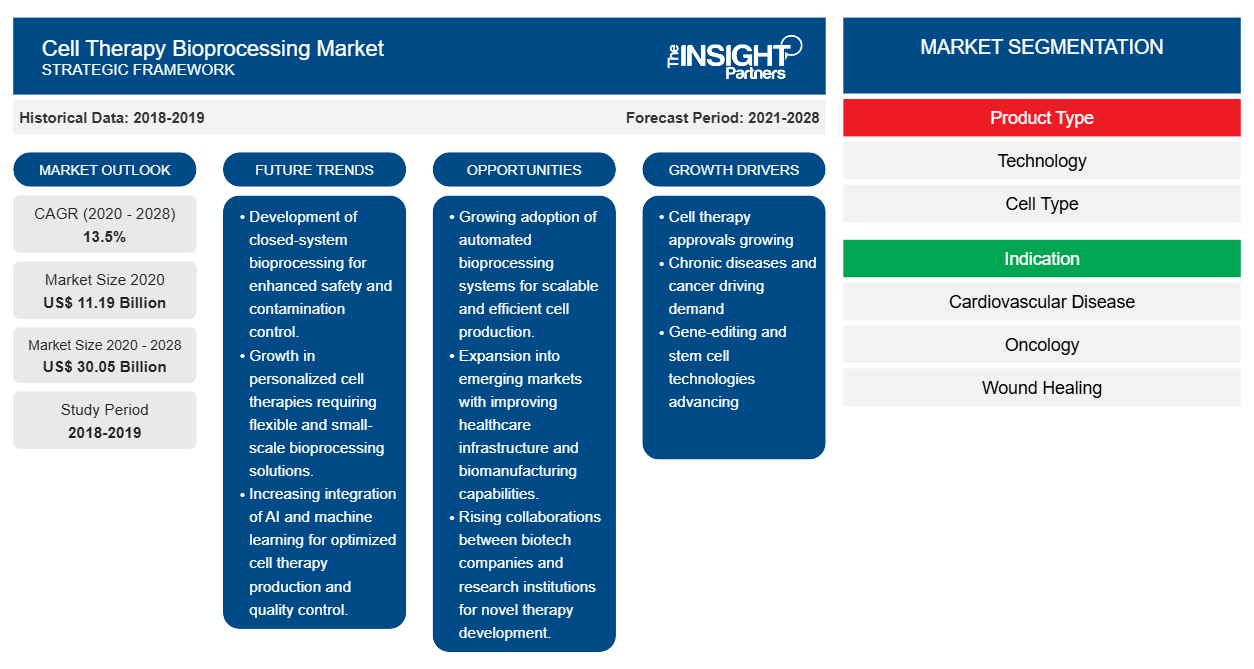
-
Get Top Key Market Trends of this report.This FREE sample will include data analysis, ranging from market trends to estimates and forecasts.
Market Insights
Growing Approvals for Cell Therapies
Cell therapies have shown positive results in treating various chronic diseases including rare genetic disorders by offering regenerative medicines and personalized medicines. Increasing need of treating chronic diseases have pushed the research and development activities resulting in growing cell therapy production and product approvals. Few instances are listed below for the cell therapies approvals that have contributed to the growth of the cell therapy bioprocessing market.
- In May 2019, the Food and Drug Administration (FDA) approved Zolgensma, manufactured by AveXis, Inc. A subsidiary of Novartis AG. Zolgensa is designed to treat spinal muscular atrophy in children below two years and is given by infusing one-time into the vein.
- In July 2020, Kite Pharma, Inc., a Subsidiary of Gilead Company, received FDA approval for its Tecartus. Tecartus is (CAR) T cell therapy designed to treat refractory mantle cell lymphoma (MCL) in adults. According to toe Gilead Company, Tecartus is the first approved (CAR) T cell therapy for mantle cell lymphoma, which is expected to be a new frontier in the treatment of mantle cell lymphoma.
- In February 2021, Juno Therapeutics, Inc., a subsidiary of Bristol-Myers Squibb Company, received approval for its Breyanzi. Breyanzi is a cell-based gene therapy intended to treat certain types of large B-cell lymphoma in adults. The treatment is given after patient have not responded to minimum two other types of systemic treatment. However, Breyanzi in 2019, faced regulatory setback since its first filing; it is currently under the European Medicines Agency’s review and was validated in July 2020.
Thus, growing product developments have resulted in various product approvals that reflects the increase in cell therapies. Therefore, it is expected that the growing approvals for cell therapies are enormously increasing the cell therapy bioprocessing, which, in turn is likely to drive the market’s growth over the coming years
Technology-Based Insights
The cell therapy bioprocessing market, by technology, is segmented into bioreactor, lyophilization, electro spinning, controlflow centrifugation, ultrasonic lysis, genome editing technology, cell immortalization technology, and viral vector technology. The Bioreactor segment held the largest share of the market in 2020, whereas the genome editing technology segment is anticipated to register the highest CAGR of 14.5% in the market during the forecast period.
Cell Type-Based Insights
The cell therapy bioprocessing market, by cell type, is segmented into stem cell, immune cell, human embryonic stem cell, pluripotent stem cell, hematopoietic stem cells. The stem cell segment held the largest share of the market in 2020, whereas the same segment is anticipated to register the highest CAGR of 14.0% in the market during the forecast period.
End User-Based Insights
The cell therapy bioprocessing market, by indication, is segmented cardiovascular disease (CVD), oncology, wound healing, orthopedic, and others. The oncology segment held the largest share of the market in 2020, and the orthopedic segment is anticipated to register the highest CAGR of 14.3% in the market during the forecast period.
Companies operating in the cell therapy bioprocessing market are adopting organic strategies such as product launches and expansions to expand their footprint and product portfolio worldwide as well as to address the growing demands.
Cell Therapy Bioprocessing Market Regional InsightsThe regional trends and factors influencing the Cell Therapy Bioprocessing Market throughout the forecast period have been thoroughly explained by the analysts at The Insight Partners. This section also discusses Cell Therapy Bioprocessing Market segments and geography across North America, Europe, Asia Pacific, Middle East and Africa, and South and Central America.
Cell Therapy Bioprocessing Market Report Scope
| Report Attribute | Details |
|---|---|
| Market size in 2020 | US$ 11.19 Billion |
| Market Size by 2028 | US$ 30.05 Billion |
| Global CAGR (2020 - 2028) | 13.5% |
| Historical Data | 2018-2019 |
| Forecast period | 2021-2028 |
| Segments Covered |
By Product Type
|
| Regions and Countries Covered |
North America
|
| Market leaders and key company profiles |
|
Cell Therapy Bioprocessing Market Players Density: Understanding Its Impact on Business Dynamics
The Cell Therapy Bioprocessing Market is growing rapidly, driven by increasing end-user demand due to factors such as evolving consumer preferences, technological advancements, and greater awareness of the product's benefits. As demand rises, businesses are expanding their offerings, innovating to meet consumer needs, and capitalizing on emerging trends, which further fuels market growth.
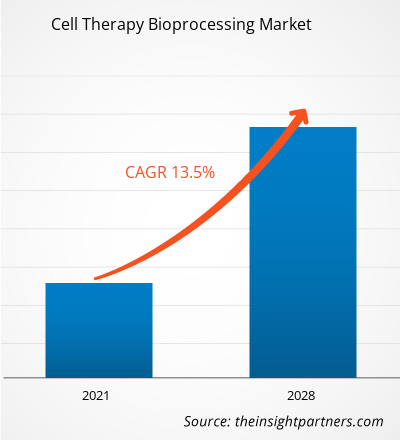
- Get the Cell Therapy Bioprocessing Market top key players overview
By Technology
- Bioreactor
- Lyophilization
- Electrospinning
- Controlflow Centrifugation
- Ultrasonic Lysis
- Genome Editing Technology
- Cell Immortalization Technology
- Viral Vector Technology
By Cell Type
- Stem Cell
- Immune Cell
- Human Embryonic Stem Cell
- Pluripotent Stem Cell
- Hematopoetic Stem Cell
By Indication
- Cardiovascular Disease (CVD)
- Oncology
- Wound Healing
- Orthopedic
- Others
By End User
- Hospitals and Clinics
- Diagnostic Centers
- Regenerative Medicine Centers
- Academic and Research Institute
By Geography
-
North America
- US
- Canada
- Mexico
-
Europe
- France
- Germany
- Italy
- UK
- Spain
- Rest of Europe
-
Asia Pacific (APAC)
- China
- India
- South Korea
- Japan
- Australia
- Rest of APAC
-
Middle East and Africa (MEA)
- South Africa
- Saudi Arabia
- UAE
- Rest of MEA
-
South and Central America (SCAM)
- Brazil
- Argentina
- Rest of SCAM
Company Profiles
- Fresenius Kabi AG
- Asahi Kasei Corporation
- Sartorius AG
- MERCK KGaA
- THERMO FISHER SCIENTIFIC INC.
- Corning Incorporated
- Cytiva
- Lonza
- Repligen
- Catalent Inc
Frequently Asked Questions
What is the cost of Cell Therapy Bioprocessing?
What are the driving factors for the Cell Therapy Bioprocessing market across the globe?
What are Cell Therapy Bioprocessing?
- Historical Analysis (2 Years), Base Year, Forecast (7 Years) with CAGR
- PEST and SWOT Analysis
- Market Size Value / Volume - Global, Regional, Country
- Industry and Competitive Landscape
- Excel Dataset
Recent Reports
Related Reports
Testimonials
Reason to Buy
- Informed Decision-Making
- Understanding Market Dynamics
- Competitive Analysis
- Identifying Emerging Markets
- Customer Insights
- Market Forecasts
- Risk Mitigation
- Boosting Operational Efficiency
- Strategic Planning
- Investment Justification
- Tracking Industry Innovations
- Aligning with Regulatory Trends












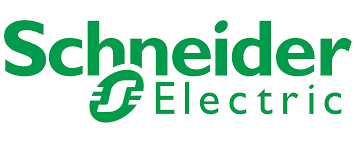


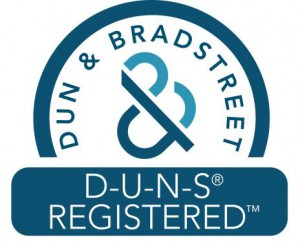
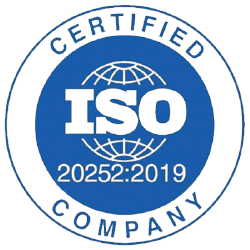
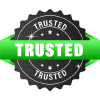



 Get Free Sample For
Get Free Sample For